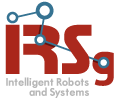Rodrigo Ventura is a (tenured) Assistant Professor at Instituto Superior Técnico (IST), Electrical and Computer Engineering department, and member of Institute for Systems and Robotics (ISR-Lisboa). He received the Licenciatura (1996), M.Sc. (2000), and PhD degree (2008), in Electrical and Computer Engineering from IST, University of Lisbon, Portugal. He has several publications in international journals and conferences, on various topics intersecting Robotics and Artificial Intelligence. He is founding member of the Biologically-Inspired Cognitive Architecture society.
He participated in several international and national research projects. In particular, he was Principal Investigator of the national project AuReRo (Human-robot interaction with field robots using augmented reality and interactive mapping, 2011-2014), and coordinator of the the IST participation in the EU LdV project USORA (Unified Solution of Remote Access in Practical Vocational Engineering Education, 2013-2015). He is currently Principal Investigator of the national project HARODE (Human-aware service robots for domestic environments).
His current research interests include human-robot interaction, human-aware navigation, decision-making under uncertainty, and cognitive robotics, targeting field, service, and space robots. He is the co-author of two national patents on innovative solutions for robotic systems.


